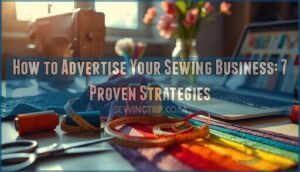This site is supported by our readers. We may earn a commission, at no cost to you, if you purchase through links.
Your sewing skills can transform fabric into something beautiful, but without customers, even the most talented seamstress struggles to stay in business.
The gap between creating stunning work and actually getting clients through your door isn’t about talent—it’s about visibility. Most sewing businesses fail not because they lack skill, but because they don’t know how to reach the people who need their services.
The good news? You don’t need a massive budget or marketing degree to advertise effectively. With the right strategies, you can connect with customers who are already searching for exactly what you offer, turning your craft into a thriving business that fills your calendar and your bank account.
Table Of Contents
- Key Takeaways
- Define Your Unique Sewing Brand
- Identify and Understand Your Target Audience
- Build a Professional Online Presence
- Leverage Social Media for Promotion
- Engage Your Local Community
- Encourage Reviews and Customer Referrals
- Measure Results and Refine Strategies
- Frequently Asked Questions (FAQs)
- Conclusion
Key Takeaways
- Your sewing business needs visibility more than talent to succeed—most businesses fail because they don’t know how to reach customers who are already searching for their services.
- A strong brand identity with a memorable name (under 12 characters), simple logo (two colors max), and consistent messaging across all channels can increase revenue by 10–23% and boost engagement by 70%.
- Focus your marketing on platforms where your customers actually spend time—Instagram for product photos, Pinterest for DIY content, and local craft fairs for face-to-face trust building that no ad can match.
- Track your results using website analytics and social media metrics to make data-driven decisions, since email marketing returns $36 for every dollar spent while SEO delivers about $22 per dollar invested.
Define Your Unique Sewing Brand
Your brand is the face of your sewing business, and it’s what people remember long after they leave your shop or website. A strong brand sets you apart from the competition and builds trust with customers who want quality work.
Here’s how to create a brand identity that sticks.
Choose a Memorable Business Name
A strong brand name is your sewing business’s first impression. Research shows brand names under 12 characters enjoy 82% better recall, while 77% of consumers form their first impression from the name alone. Your choice shapes your brand identity and marketing strategy long-term. Companies should also consider how unique names help set a brand apart.
- Keep it short and easy to pronounce – Complex spellings reduce engagement by 73%, so prioritize pronunciation ease
- Check legal availability and domain names – Secure your.com early to avoid trademark conflicts
- Make it distinctive yet descriptive – Balance brand distinctiveness with clarity about your sewing services
Design a Distinctive Logo and Tagline
Once you’ve nailed down your business name, your logo and tagline complete your brand identity. First impressions form in just 7 seconds, so visual impact matters. Research shows 62–90% of snap judgments hinge on color psychology, while brands using one or two colors gain 80% better recognition. A catchy tagline boosts recall—37% of consumers strongly agree taglines create lasting impact even when product details fade. Brand recognition can occur in milliseconds, underscoring the importance of a strong visual identity.
Logo Design Options for Your Sewing Business
| Option | Cost Range | Best For |
|---|---|---|
| DIY online logo makers | $0–$100 | Tight budgets, quick launch |
| Freelance designers | $300–$1,300 | Custom work, moderate investment |
| AI design tools | $50–$200 | Speed and experimentation |
| Professional studios | $1,000+ | Established brands seeking polish |
| Template customization | $20–$150 | Simple, recognizable marks |
Keep your logo simple—95% of top brands stick to two colors max. Blue dominates 40% of Fortune 500 logos because it signals trust. If you’re drawn to DIY logos (36.7% of small business owners are), make sure your design scales across signage, packaging, and social media without losing clarity. Vector formats maintain quality at any size.
Your tagline should be brief and rhythmic. Think three to five words that capture your sewing expertise. Test it: Does it stick after one hearing? Does it hint at what makes your work special? Pair logo memorability with tagline impact, and you’ll anchor your brand image in customers’ minds before they even see your first stitch.
Maintain Consistent Branding Across Channels
Your logo and tagline won’t do much if your brand voice shifts from Facebook to your storefront. Brands maintaining visual consistency across channels see revenue increases of 10–23%. Omnichannel experience matters: aligned messaging boosts engagement by 70% and lifts conversions by 57%. That’s the power of brand awareness working across the customer journey.
Keep brand identity uniform:
- Match your profile images and colors on Instagram, Facebook, and your website so customers recognize you instantly
- Use the same fonts and tone in emails, blog posts, and packaging to strengthen brand image
- Mirror your tagline and messaging across ads, signage, and social bios for fluid brand building
Identify and Understand Your Target Audience
You can’t advertise effectively if you don’t know who you’re talking to. Understanding your target audience means looking at who needs your services, what problems you solve for them, and where they spend their time.
Here’s how to get clear on your ideal customers and tailor your marketing to reach them.
Analyze Customer Demographics and Needs
Start with customer profiling to understand who’s actually buying your services. Women aged 30 to 69 drive nearly half of alterations and custom work, while younger buyers under 35 now represent 32% of the craft market.
Use surveys and customer feedback to build buyer personas that capture demographics, motivations, and spending habits. This demographic analysis reveals whether you should focus on bridal alterations, everyday repairs, or DIY enthusiasts.
Research Local and Online Market Trends
By tracking market trends through Google Analytics and social media, you’ll spot where demand is heading. The global sewing machine market is climbing to $6.9 billion by 2030, while Etsy searches for “bag sewing pattern” jumped 13% last year.
Customer surveys and competitive analysis reveal what’s hot locally—whether it’s alterations, DIY kits, or sustainable upcycling. Market segmentation helps you focus resources where growth lives.
Study Competitors in The Sewing Industry
Who’s winning customers in your area? Competitor analysis shows that 73% of alteration shoppers prefer local seamstresses over chains, giving you an advantage.
Check rival pricing—alterations rose 15% since 2023—and study their digital strategies using tools like Semrush. Notice their turnaround times (most average 7–10 days) and service benchmarking.
Market research on advertising tactics helps you spot gaps and improve your own marketing strategies.
Build a Professional Online Presence
Your website is often the first place customers will check you out, so it needs to make a strong impression. A professional online presence helps you look credible, reach more people, and turn visitors into paying clients.
Here are three key steps to build a website that works for your sewing business.
Create a Mobile-Optimized Website
Your online presence depends on how your website looks and works on a phone. Nearly 59% of all website traffic now comes from mobile devices, so a mobile-optimized website isn’t optional.
Here’s what makes your site mobile-ready:
- Responsive design that adjusts smoothly to any screen size
- Fast page speed under 3 seconds to prevent bounce rates from hitting 53%
- Clear navigation with contact details visible immediately
This foundation bolsters both user experience and SEO optimization before you add e-commerce integration.
Integrate E-Commerce Functionality
Adding ecommerce functionality turns your site into a sales engine. Choose an ecommerce platform that fits your budget and tech comfort—Shopify and WooCommerce are popular choices. Set up secure payment gateways so customers can checkout smoothly.
Focus on mobile optimization since 75.50% of cart abandonment happens on phones.
Consider product configurators that let shoppers customize items, boosting customer conversion by up to 35%.
Optimize Website for SEO and Local Search
Did you know nearly half of Google searches are local? If you want your sewing business to stand out, focus on search engine optimization and mobile optimization. Fast site speed and clear website design help customers find you quickly.
Strengthen local discovery with:
- Keyword research for your area
- Local citations and Google Business Profile
- Schema markup for services
- Mobile-friendly pages
Leverage Social Media for Promotion
Social media isn’t just a nice-to-have anymore—it’s where your customers spend their time scrolling, searching, and discovering new makers. With 96% of small businesses already using these platforms, you can’t afford to sit on the sidelines.
Here’s how to turn likes and follows into real customers for your sewing business.
Choose The Right Platforms (Instagram, Pinterest, Etc.)
Not every social media platform will work for your sewing business. Instagram thrives on product photos and videos, with 81% of users researching products there in 2024. Pinterest excels at DIY and craft content, driving more sales for many small craft brands than any other platform. TikTok builds buzz through quick demos and tutorials.
Choose platforms where your audience engagement naturally happens, then focus your content strategy there.
Share Sewing Tips, Tutorials, and Behind-the-Scenes Content
Once you’ve picked your platforms, fill them with sewing tips, tutorials, and behind-the-scenes content that show your work in progress. Video marketing drives engagement—87% of businesses using video content report positive conversion benefits. Share quick how-tos, fabric selection guides, and real stitching sessions. Educational content builds trust, and authentic posts keep your audience engaged better than polished ads ever could.
Content ideas that connect:
- Quick 30-second technique videos showing tricky seams or pressing hacks
- Process shots of projects from cutting table to finished garment
- Short tutorials on zipper installation or pattern adjustments
- Real mistakes and fixes that humanize your expertise
Use Hashtags, Contests, and Influencer Collaborations
Your sewing tips gain traction when you pair them with a hashtag strategy that balances broad reach and niche discovery. Posts with 9 to 11 hashtags boost reach by nearly 80%, helping you connect with sewists searching for specific techniques.
Run online contests that spark UGC engagement—user-generated content drives 70% more social media engagement than ads. Partner with micro-influencers who deliver $4.12 in influencer ROI per dollar spent, turning their trusted recommendations into measurable contest mechanics and conversions.
Engage Your Local Community
Your sewing business doesn’t have to live only online. Getting out and meeting people face-to-face builds trust in ways no ad can match.
Here are three practical ways to connect with customers in your own backyard.
Participate in Craft Fairs and Markets
Setting up at craft fairs and markets puts your work directly in front of interested buyers. Carefully evaluate each event before committing—aim for ten times your booth fee in sales. Strong vendor networking at industry events creates opportunities for future opportunities.
- Design an eye-catching booth display that showcases your unique pieces
- Research event selection criteria like foot traffic and vendor reviews
- Plan inventory based on price points that encourage impulse purchases
- Test pricing strategy by comparing similar handmade goods at local events
- Track which markets deliver the best return for smart inventory planning
Host Sewing Classes or Workshops
After drawing in buyers at your booth, offering sewing classes and workshops builds lasting connections with your local community. Set class pricing based on skill level—beginners often pay $50 to $100 per session, while higher-level techniques command higher rates.
Choose accessible venue options like community centers or your studio, plan workshop themes around trending techniques, and source materials in bulk to keep costs manageable while positioning your business as the go-to learning destination.
Partner With Local Businesses and Events
When you team up with nearby boutiques or fabric shops, you tap into a ready-made customer base that already loves handmade goods. Joint promotions—like co-hosting collaborative workshops or event sponsorships at industry events—spread your name fast.
Cross-marketing through community outreach builds trust while splitting costs, and community building efforts at local events often boost foot traffic by up to 20 percent.
Encourage Reviews and Customer Referrals
Nothing builds trust faster than hearing from happy customers. When people see real reviews and hear genuine recommendations, they’re more likely to choose your sewing business over the competition.
Let’s look at three simple ways to turn satisfied clients into your most powerful marketing tool.
Request Testimonials for Social Proof
Your customers’ words carry more weight than any ad you’ll ever write. Around 76% of shoppers check reviews before visiting local businesses, so actively request testimonials through follow-up emails, quick surveys, or direct asks right after completing a project.
Here’s how to turn customer reviews into credibility signals:
- Display testimonials prominently on your homepage and service pages for review prominence
- Use format variety—mix written quotes, photos of finished projects, and video testimonials
- Share testimonials online across social media, Google, and Yelp to spread social proof
- Respond to at least 25% of reviews as part of your response strategy to build trust
Businesses with strong customer testimonials can see conversion increases up to 270% when using customer reviews effectively.
Offer Referral Discounts and Incentives
Beyond testimonials, a referral discount program can boost word of mouth by turning satisfied clients into active promoters. Companies with structured incentive tiers see conversion rates up to 71% higher, and referred customers show 16% higher customer lifetime value.
Referral programs with incentive tiers can boost conversion rates by 71% and increase customer lifetime value by 16%
Try a “20-for-20” referral structure—your existing client shares a 20% discount while earning credit toward their next alteration. This discount framing creates viral loops that boost both customer acquisition and retention without expensive promotions.
Share Customer Projects and Feedback Online
Visual project showcases turn satisfied customers into your most persuasive sales team. When you share customer projects and feedback online, you build trust and credibility that impacts purchase decisions far more than polished ads.
Campaigns featuring user-generated content achieve 29% higher conversion rates, and around 74% of consumers rely on customer reviews and social media marketing posts when choosing where to spend their money.
Measure Results and Refine Strategies
You can’t improve what you don’t measure. Tracking your marketing efforts shows you what’s working, what’s not, and where to invest your time and money.
Here’s how to use data to sharpen your sewing business strategy and get better results.
Track Website and Social Media Analytics
You can’t improve what you don’t measure. Use Google Analytics to watch your website KPIs like traffic sources and bounce rates, while social media platforms reveal engagement metrics that matter.
By analyzing and tracking results regularly, you’ll spot trends, understand what resonates with your audience, and make data-driven decisions. Don’t forget competitor analysis—it shows you what’s working in your market.
Monitor Campaign Performance and ROI
Measuring and analyzing results isn’t guesswork—it’s about tracking KPIs that reveal what’s working. Email marketing can return for every dollar you invest, while SEO delivers about $22 per dollar spent.
Monitor advertising results by analyzing return on investment for each channel, then improve tactics to adjust spend. When you measure impact consistently, you’ll know exactly where your money works hardest.
Adjust Marketing Tactics Based on Data
Once you’ve gathered performance indicators, use them to make data-driven decisions that boost your bottom line. A/B testing reveals which ads, emails, and posts convert best, so you can shift budgets toward what works. Strategic adjustments based on analyzing return on investment turn good campaigns into great ones—ROI improvement comes from tweaking, not guessing.
- Test subject lines and visuals weekly to discover what your audience can’t resist clicking
- Reallocate ad spend monthly by moving dollars from underperforming channels to proven winners
- Automate alerts for key metrics so you catch drops in performance before they drain your budget
Frequently Asked Questions (FAQs)
How can I create a compelling content strategy for my sewing business?
Around 60% of top content marketers consistently align their brand’s voice across every piece—clarity fuels success.
Your content strategy starts with defining your brand identity, understanding your audience, planning diverse formats, and tracking performance metrics to improve what works.
How can I measure the success of my sewing business marketing efforts?
Track website conversion rates, social engagement, and customer acquisition cost to understand ROI.
Use Google Analytics for monitoring advertising results, then adjust your strategy based on data to boost brand awareness and profitability.
How much should I budget for advertising costs?
You’ll want to allocate 7% to 8% of your gross revenue to marketing, with advertising campaigns taking about 15% to 20% of that total—usually $1,200 to $1,600 annually for most small sewing businesses.
What paid advertising platforms work best for sewing?
Meta ads and Pinterest ROI deliver strong results for sewing businesses. Google Shopping, Etsy advertising, and YouTube ads also work well. Your advertising strategy should blend these online advertising methods based on campaign performance data.
How do I handle negative reviews professionally?
Acknowledge feedback promptly, stay professional, and offer solutions to rebuild customer relationships.
Move offline for detailed discussions, then use insights to improve processes and strengthen your online reputation through better customer service and engagement.
Should I offer custom orders or ready-made items?
You’re not choosing between two paths—you’re mapping demand. Custom orders deliver 30–50% profit margins and deepen loyalty, while ready-made items scale faster, reach broader markets, and align with customer expectations for convenience.
When is the best time to launch promotions?
Launch promotions during seasonal peaks like November–December, targeting weekends and early-week mornings (9–11 a.m.) for email marketing.
Plan campaigns 90 days ahead to increase cost effectiveness while offering discounts that create urgency and drive conversions.
Conclusion
Your sewing machine sits ready, but success requires more than thread and talent. Learning how to advertise your sewing business bridges that gap between silent potential and steady income.
These seven strategies give you clear paths to visibility, from building your brand to measuring what works. Start with one approach today, track your results, and expand from there. Your skills deserve an audience, and now you have the roadmap to reach them.
- https://www.amraandelma.com/craft-platform-marketing-statistics/
- https://cropink.com/social-media-for-business-statistics
- https://stitchcraftmarketing.com/podcast/business-of-craft-2025-building-community/
- https://www.sprinklr.com/blog/social-media-marketing-statistics/
- https://www.madeurban.com/blog/7-stats-to-track-at-craft-shows-to-improve-sales/















